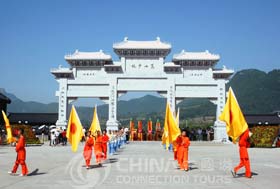Located in the northwest of Dengfeng County and reputed as the Central Sacred Mountain among China's five sacred mountains, Mt. Songshan Stretches more than 60 km across from east to west. It consists of two mountains-Taishi and Shaoshi,with 36 Deaks alto ether. It is about 70 Km from Zhengzhou and the trip takes about 2 hours. Its highest peak is 1440 meter.
 Mt. Songshan got its fame from being the place where the Indian monk Batuo founded the Shaolin temple in 495 A.D. Few years later in 527 A.D. another Indian monk, Damo (or Bodhidharma) moved to the temple to teach the Chan sect of Buddhism, best known as Zen Buddhism (Zen is the way Japanese read the Chinese ideogram for Chan). Buddhism was been already introduced in China during the first century B.C., but the cultural differences between India and China made the strict Hinayana sect to be not well accepted. The Chan version was instead more adapt to the Chinese culture and became rapidly the most influential Buddhist sect in China.
Mt. Songshan got its fame from being the place where the Indian monk Batuo founded the Shaolin temple in 495 A.D. Few years later in 527 A.D. another Indian monk, Damo (or Bodhidharma) moved to the temple to teach the Chan sect of Buddhism, best known as Zen Buddhism (Zen is the way Japanese read the Chinese ideogram for Chan). Buddhism was been already introduced in China during the first century B.C., but the cultural differences between India and China made the strict Hinayana sect to be not well accepted. The Chan version was instead more adapt to the Chinese culture and became rapidly the most influential Buddhist sect in China.
Mt. Songshan has rich forest resources, some of which are rare ancient trees with odd figures and literary Quotation, such as the General Cypress in the Songyang Academy, the Fifth-rank Chinese Scholar tree in the Shaolin Temple, the Han (206BC-220AD) Maidenhair Tree in Fawang Temple, the Cypress Forest in the Zhongyue Temple, and the Bodhi tree in the Yongtai Temple, etc. The forest resources of Songshan are praised as "rare treasure" for their large quantity, antiquity, abundant literary quotation and vivid shapes.
The mountain also boasts a large number of showplaces and cultural relics. The most famous Shaolin Temple is located here, where Shaolin monks exercise Qigong and other Shaolin Kong-fu (martial arts). There are some other temples in the mountain, such as the Zhongyue Temple, which is nicknamed "the Little Palace"; the Fawang Temple and the Huishan Temple, the oldest temples extant in China; two earliest and well-preserved astronomical observatories extant in China; etc.
Mt. Songshan abounds in stele carvings, totaling more than 2,000 pieces, left by famous calligraphers like Yan Zhenqing, Su Dongpo, Huang Tingjian and Mi You, etc.

